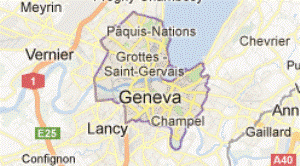ENVIRONMENT » TRUTH ADDICT
NYT Fails to Cover Civilization Collapse
March 20, 2014 · 0 Comments

Above: A near empty NYT newsroom. Photo from Wikicommons.
By Michael M'Gehee:
“All the News That’s Fit to Print.”
That is the motto of the New York Times, the so-called “paper of record.”
Over the last few years we here at the NYTimes eXaminer have shown time and time again that who or what determines what is “fit” reveals a lot about the ideological leanings of the newspaper. The working model for this explanation is Noam Chomsky and Edward Herman’s “Propaganda Model,” which argues successfully that certain “filters” (i.e. ideology, ownership, advertisement, sources, and flak) determine what is worthy and what is unworthy to report. That is, the political and economic interests of a newspaper plays a significant role in what will receive coverage.
But this latest example of what the NYT decides is “fit to print” is an obvious example of negligence.
Scientists at the National Socio-Environmental Synthesis Center recently published an NASA-funded study on the prospects of a complete collapse in civilization.
Their report (“Human and Nature Dynamics (HANDY): Modeling Inequality and Use of Resources in the Collapse or Sustainability of Societies”) is based on a meticulously-constructed model, which according to the study “was inspired by the Predator and Prey model, with the human population acting as the predator and nature being the prey.”
The study states that while “Technological change can raise the efficiency of resource use,” the problem is that “it also tends to raise both per capita resource consumption and the scale of resource extraction, so that, absent policy effects, the increases in consumption often compensate for the increased efficiency of resource use.”
“Given economic stratification, collapse is very difficult to avoid and requires major policy changes, including major reductions in inequality and population growth rates,” the study says.
In one scenario:
the decline of the Commoners occurs faster, while the Elites are still thriving, but eventually the Commoners collapse completely, followed by the Elites. It is important to note that in both of these scenarios, the Elites—due to their wealth—do not suffer the detrimental effects of the environmental collapse until much later than the Commoners. This buffer of wealth allows Elites to continue “business as usual" despite the impending catastrophe. It is likely that this is an important mechanism that would help explain how historical collapses were allowed to occur by elites who appear to be oblivious to the catastrophic trajectory (most clearly apparent in the Roman and Mayan cases).
According to the study, “The scenarios most closely reflecting the reality of our world today” involve a complete collapse of civilization because “current trends in population and resource-use are unsustainable.”
This is very alarming.
While various news agencies around the world quickly picked up and reported the study, the New York Times has yet to provide any coverage.
Times’ readers should wonder why it is that the “paper of record” does not find the prospects of a full-collapse of civilization “fit to print.”
In addition to the failure noted above, there has been another relevant study recently published, and the Times has likewise also, as of today, failed to report on it.
In Richard Heede’s paper “Tracing anthropogenic carbon dioxide and methane emissions to fossil fuel and cement producers, 1854–2010” it is shown that, “63 % of cumulative worldwide emissions of industrial CO2 and methane between 1751 and 2010” are traced to “90 ‘carbon major’ entities.”
Heede found that a significant portion of these emissions have “been emitted since 1986.”
For Heede, the problem is systemic to the market-based economy.
“Energy companies have strong financial incentives to produce and market their booked reserves and oppose efforts to leave their valuable assets in the ground,” he observed.
While the “Human and Nature Dynamics” report stresses that “collapse is very difficult to avoid and requires major policy changes, including major reductions in inequality and population growth rates,” Richard Heede’s report notes that the dominant economic system behind the prevailing “economic stratification” has “strong financial incentives to produce and market their booked reserves and oppose efforts” that would stave off the kind of collapse in question.
All the while, the New York Times has so far failed to report the findings of either report.
And, that, is "business as usual."
By admin










Sorry, comments are closed on this post.